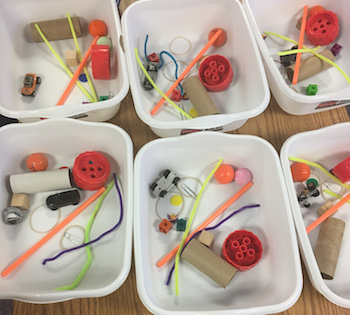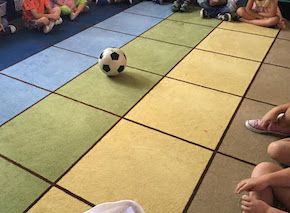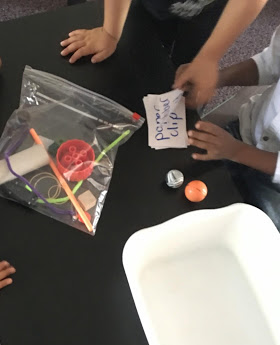






Objects do not move on their own.
Observe, record, and share data about what causes motion.
Game balls do not move on their own.
Click here for NGSS, CCSS-ELA, and California ELD standards.
How do balls move in games like soccer?
The anchoring phenomenon is “Objects do not move on their own.” This lesson introduces students to a real-world context for how pushes and pulls are used to make objects (balls) move in soccer and other games. In this first lesson, the anchoring phenomenon (motionless ball) is used to generate ideas and ask questions about ways to move a soccer ball. (SEP) Students’ prior knowledge about how balls are made to move in soccer is accessed through discussion and a video of a soccer game. (DCI) (CCC)
Once the motionless ball is moved, then the investigative activity uses the motionless objects in the exploration box to figure out different methods for moving or stopping objects. (DCI, SEP) Movement or stopping of any object (effect) has a cause that can be described as a push or pull. (CCC) This learning experience offers opportunities for you to support student use of words describing a push or a pull that causes movement or stopping of movement. (Embedded vocabulary)
Understanding the investigative phenomenon “Game balls do not move on their own” will lead to understanding the anchoring phenomenon “Objects do not move on their own.” The objects in the box are moved or stopped by pushes or pulls, leading to understanding both the motion and the academic words used to describe the force. The lesson concludes with a class assessment opportunity by completing the “What do we know about moving objects such as soccer balls?” in their kindergarten science notebook (or the Class Notebook). (DCI)
This leads to the investigative problem presented in the next lesson, where the coach describes the problem of figuring out a way to move soccer equipment to the field in one trip. Students generate questions to understand the problem and design a solution.
Throughout the lesson, a flag ( ) denotes formative assessment opportunities where you may change instruction in response to students’ level of understanding and making sense of phenomena.
) denotes formative assessment opportunities where you may change instruction in response to students’ level of understanding and making sense of phenomena.
| 5 minutes | Engage |
| 15 minutes | Explore |
| 10 minutes | Explain |
| 5 minutes | Elaborate/Evaluate |

Observe a motionless ball, ask questions, and make predictions about what causes a ball to move.
Kindergarten students ask questions in the moment. They are not good at remembering those questions and sharing them at the end of an investigation. You should be prepared to collect questions you hear students asking as you check in with groups. Chart some of the observations made and new questions to explore on the K.1.C1: Class Notebook at the end of each lesson. As the lessons progress and students see their questions in writing, they will begin to remember and ask their own questions about the sequence of investigations.
The K.1.C1: Class Notebook is used throughout the learning sequence to model writing and understanding of concepts of print. The entries are used as a text for reading as well as a source for information developed by the class. If the sequence is done later in the kindergarten year, more of the entries could be included in an individual student notebook.

During step 4, use a think-aloud to model thinking about pushes and pulls. This think-aloud helps the students think on their own in step 7b and 7c and verbalize the results of the pushes and pulls in step 12.
Plan and carry out an investigation and observe how objects move when pushed or pulled.
Refer to Steps 4 and 5 in Advance Preparation to introduce the cards and materials for this part of the investigation. This will support the development of student language as well as concepts of print for communicating ideas, e.g. left to right, words versus letters, whole thoughts as sentences. Include words about the objects they will be using such as: train cars, balls, bears, cars, paper clips, pipe cleaners, soup cans, rubber bands, straws, ruler. See the picture there for an example.



As students are exploring, walk around and listen for prior knowledge of predictions, the position of objects, cause and effect (CCC), and vocabulary words such as push, pull, cause, and effect. Watch for the ways in which students observe and describe causes or patterns of how different pushes or pulls affect the movement of the ball. Listen to how the students explain their observations in order to build on their vocabulary for the next exploration. Use the words push, pull, cause, and effect to expand language for students who do not yet use the words. The labeled zipper bags/or word wall with objects also supports language for English Learners or students building schema.
Analyze and interpret observations about the effects of a push or pull on movement.


I pushed _____ by _____.Use a combination of pictures and words to record their explanations. For example, use arrows to show the direction the object moved.
I pulled _____ by _____.Continue to chart.
I stopped _____ by pulling or pushing the opposite direction.Chart ideas for stopping under the appropriate push or pull column.
The sentence frames are intended to be suggested by you only if students need scaffolds. Simpler sentence frames can be used if needed by a class. Kindergarteners are interacting with written text in the form of objects and pictures.
Throughout the learning sequence, adapt for different abilities in reading charts by using individual readers, partner readers, or choral reading led by you.
The experience of understanding cause and effect will depend on the prior discussion in the class. Build on charted student responses to identify what causes something to move. Facilitate student responses to build understanding that there is a cause for all movement or stopping movement. The causes include either a push or a pull.
 Have students return to tables and take out their kindergarten science notebook or a piece of paper. Ask students to pick an object they either pushed or pulled. Have them use pictures, words, and arrows to show what they did (cause) and what happened to the object (effect).
Have students return to tables and take out their kindergarten science notebook or a piece of paper. Ask students to pick an object they either pushed or pulled. Have them use pictures, words, and arrows to show what they did (cause) and what happened to the object (effect). Drawing the picture in step 18 provides both additional practice and an opportunity for embedded assessment of the connections students are making between the action and the words of push and pull. This activity can be done at a choice center for as long as students indicate an interest in sorting the cards. Record observations of student’s ability to distinguish between both the two words and the actions. This activity further supports English Learners in speaking and listening. The activity can also be adapted for extended learners by placing words on the cards rather than pictures of the objects.
Drawing the picture in step 18 provides both additional practice and an opportunity for embedded assessment of the connections students are making between the action and the words of push and pull. This activity can be done at a choice center for as long as students indicate an interest in sorting the cards. Record observations of student’s ability to distinguish between both the two words and the actions. This activity further supports English Learners in speaking and listening. The activity can also be adapted for extended learners by placing words on the cards rather than pictures of the objects.
Construct an explanation about the cause of the movement of a motionless soccer ball.
 Display the K.1.C1: Class Notebook and bring the students back to the meeting area with the soccer ball in the center. Ask, “Think about the way you moved the things in the box. What do we know about moving objects such as soccer balls? What did we figure out about how a motionless soccer ball is made to move?” Chart student ideas and record what they figured out about the movement of motionless objects (anchoring phenomenon) in the K.1.C1: Class Notebook.
Display the K.1.C1: Class Notebook and bring the students back to the meeting area with the soccer ball in the center. Ask, “Think about the way you moved the things in the box. What do we know about moving objects such as soccer balls? What did we figure out about how a motionless soccer ball is made to move?” Chart student ideas and record what they figured out about the movement of motionless objects (anchoring phenomenon) in the K.1.C1: Class Notebook.It would be appropriate to have students interact with text to extend their understanding of pulls. These selections can be read aloud at any time after this lesson because students have experienced pushes and pulls. Suggested books include:
Fiction:
Nonfiction:
Brett, J. (2015). The Turnip. New York: Putnam Juvenile.
Casas, D. D., & Gentry, M. (2010). The Gigantic Sweet Potato. Gretna, LA: Pelican Publishing Company.
Davis, A., & Petričić, D. (2018). The Enormous Potato. Winnipeg, MB: National Network for Equitable Library Service.
FC Barcelona. (2016, December 29). Search Avatar image 0:17 / 2:35 [HIGHLIGHTS] LALIGA PROMISES: FC Barcelona (Infantil B) – Real Madrid 2–0. Retrieved from https://www.youtube.com/watch?v=CvbIAaEgKjc
Hester, D. L., & Urbanovic, J. (2015). Grandma Lena’s Big Ol’ Turnip. New York, NY: Albert Whitman Prairie Books.
Llewellyn, C., & Abel, S. (2005). And Everyone Shouted, “Pull!”: A first look at forces and motion. Minneapolis, MN: Picture Window Books.
Peck, J., & Root, B. (1998). The Giant Carrot. New York: Dial Books for Young Readers.
Stihler, C. B., & Trammell, J. (2003). The Giant Cabbage: An Alaska folktale. Seattle, WA: Sasquatch Books.
Tolstoy, A. N., & Sharkey, N. (2019). The Gigantic Turnip. Cambridge, MA: Barefoot Books.